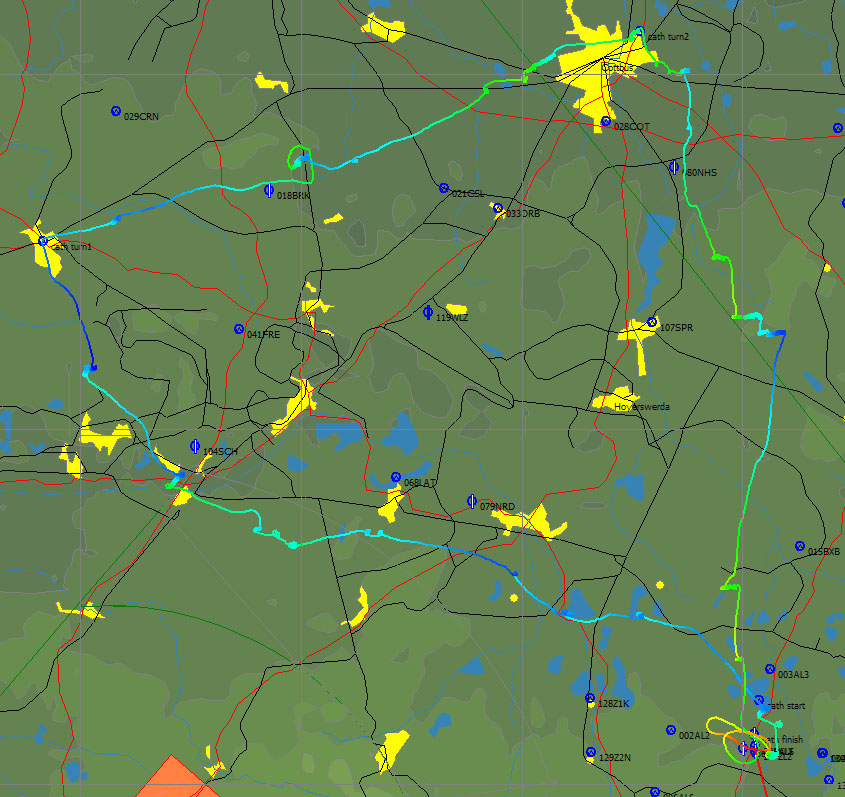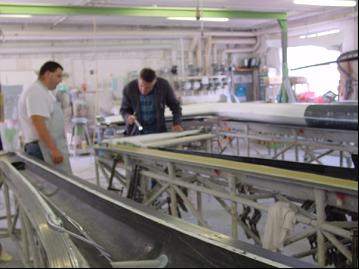
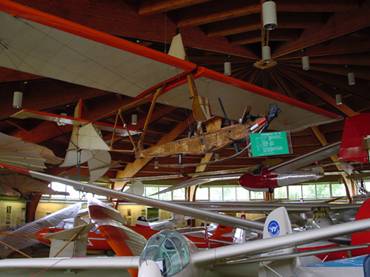
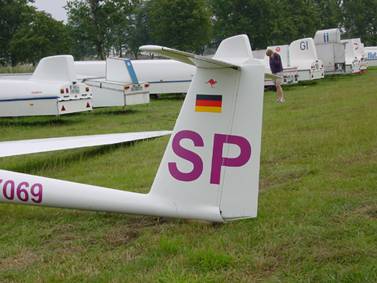
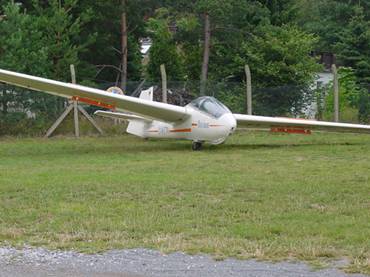
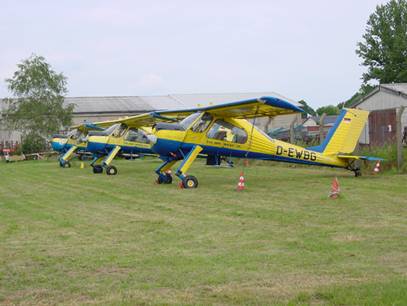
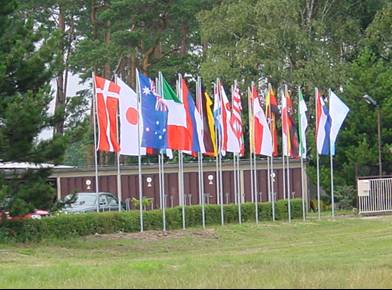
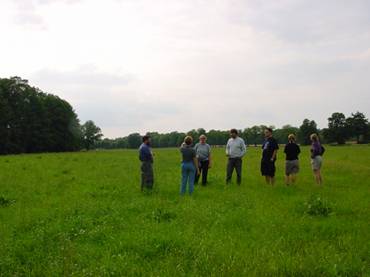
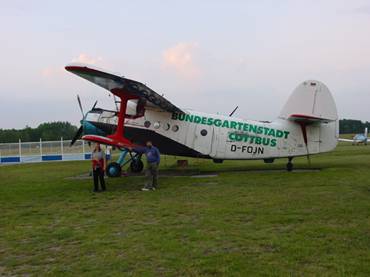
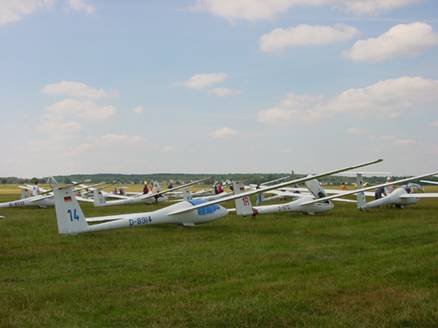
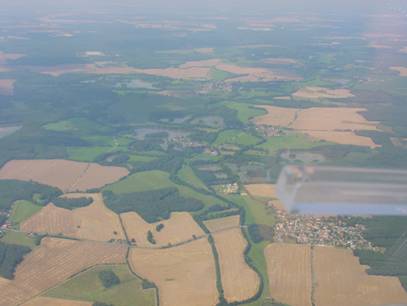
Thursday 22/7/04
I arrived into Frankfurt Airport at 5:45am having managed maybe 4 hours sleep. I was met by Sabine and then Steve Kittle who had flown in the night before and spent the night at a hotel near the airport.We piled into the VW Passat, which is a diesel powered stationwagon and looks to be quite a useful gliding vehicle.
We headed to the Schleicher factory where a tour was organised for us by Bernard Eckey - the Australian agent. They were wonderful at the factory, spending 2 ½ hours with us showing us every stage of production. Our timing was excellent and we witnessed the "birth" of an ASH-25 fuselage as it emerged from the moulds. We were also able to see wings being laid up, sanding, polishing, final fitout and many other parts of the glider production process.
To date the only other factory I had ever visited was the Edmund Schneider factory at Gawler, but that was not operational at the time (but still interesting, particularly as a Boomerang owner at the time).
After leaving Schleicher, we headed for the Wasserkuppe.
We visited the museum where there were some wonderful old gliders including a Bergfalke I, Phoenix, Grunau Baby, SG38 Primary (made by Schneiders) Minimoa and many others. We had a great conversation with the museum curator (enabled by Sabine acting as our translator). He was particularly interested in talking to us since we knew Harry Schneider and Martin Simons (whose books are on sale at the museum).
Then we embarked on the obligatory walk to the eagle monument, pausing only to watch winch launching from one of four clubs currently operating at the site. There is also an aerotow club taking tourists for flights and an old timers club who were launching a SG38 primary with a bungee. Unfortunately we had to leave before we could watch that since we still had more than 400km to drive to Klix.
The drive was a mixture of slow country roads with towns every couple of km and the autobahn where there was no speed limit and Steve and I both had turns driving at speeds exceeding 180kph, and being passed by Mercs and BMWs as if we were standing still.
Swaantje and some of her friends were happy to see us finally arrive since they were hungry and it was 8pm. Well overdue for dinner. We went into town to a local pub and had the menu translated for us. I'm not sure what we would have eaten if we had tried to go by ourselves.
Friday 24/5/07
We woke up to low cloud/fog but were assured it would burn off by 9:30am - which it did leaving us with a lovely warm sunny day in the high 20's. We readied the two Lisa's gliders which included some time working out where to mount Cambridge loggers, winpilot IPAQs and how to get comfortable in unfamiliar gliders. We also applied the all important "Red Kangaroo" stickers to the fin of the gliders.Both girls are flying LS4s in Standard Class. Lisa Trotter (L1) has "14". Lisa Turner (L2) has "SP"
Their flying revealed some problems with the compensation in both the mechanical and electric vario in "SP". Steve and I spent some time trying to determine where the leak might be that would cause such a problem, Helge came to help and found a plumbing problem with the LX vario. He also lent us the probe from his LS1.
While the girls were flying, Steve and I expressed interest in the Bocian and the Wilga tug. Keith was quicker than we were and was invited into the tug for the first tow. He found it an interesting experience, particularly when it began backfiring on final (something that is completely normal - even if it does sound like parts of the aeroplane are falling off when you sit in it).
I had a check flight with Dieter, a contest organiser and local instructor in the Bocian. Contrary to my opinion about german winchlaunching, he stressed that I was not allowed to be in full climb below 50m.
We were up almost an hour and I was once again able to remind myself how well Bocian's spin (in both directions), and loop, and do wingovers etc.
Obviously I scared their instructor too much because he suggested that I fly with Steve next. He must have had enough of Australian pilots :-). Seriously he was just another example of how friendly and accommodating the people here are. Nothing is too much trouble (except maybe English briefings but we shall see).
Saturday 25/7/04
Today when we woke up, there was low cloud again. But this time, there was also high cloud above the low cloud, and the chance of it all burning off was non-existent.Still there were a number of useful things that we could achieve. Lisa Turner's LS4 still required test flying to see if the changes to the instrument plumbing and the installation of Helge's probe had solved her problems.
Registration and weighing started this morning and we weighed both gliders early before the line became too long.
Much more paperwork is required for registration than we need in Australia, however, unlike Australia; the organisers don't need to see it. You need to initial each line item in a form to confirm that the paperwork is valid and you have it, but the responsibility is on the pilot, not the organisers. You need to sign that you have a certificate of registration, a certificate of airworthiness, an annual inspection for the glider, a valid radio test certificate for the glider, a valid pilot's licence, an FAI licence, a valid aviation medical, a radio operators licence, a parachute packing certificate, 3rd party insurance certificate and a declaration that if your glider was only fitted with a belly hook, that you had done 5 aerotows in the last 6 months on that hook.
There was a disclaimer and other wording to sign against on the entry form which was difficult since it was all in German legalese. We took the forms back and had them translated but requested an official translation from the organisers.
Lisa Trotter needed another hose to connect to the water ballast pump, so Steve and I went shopping with Swaantje, Helge and Sabine. Its amazing how many people you can cram in the VW Passat!
First we went to a large hardware shop - similar to Bunnings although the range of merchandise extended to bicycles and camping equipment. We found some plastic tubing with the correct inside-diameter for the hose but couldn't find any spiral conduit that we could use to get Lisa Trotter's instrument cabling under control. I also bought a small torch and some batteries for my GPS. (Although I hope I never need it on a retrieve). Then while the others looked for what they needed, Steve and I looked at the range of tools, including powered tools. We didn't find the really nifty sander that the fellow at the Wassekuppe had been using to scarfe the Flying Wing. Probably just as well.
After some lunch in the food court, we did some shopping in the supermarket to restock what was needed in the camp ground and headed back to the airfield.
By this time, L2 had test flown her instruments and to my relief, they were behaving properly. We fitted the hose the L1's ballast pump and both L's were able to fill their gliders and determine their dump time.
There are now 4 Wilga's tied down looking like 4 ponderous dragonflies. All are painted identically in blue and yellow.
The flags have been raised too. 16 flags for each of the German regions, plus the Russian, Japanese, Danish and Australian flags. I must admit I have never seen the Australian flag flown mounted at 90o before.
We derigged the LS4's while I had another chat to the contest director (with the help of Sabine) to explain that we really needed an English translator during briefing. And that we couldn't use Swaantje s- it was not fair to impose on her since she is a competitor. He promised to organise someone.
Over lunch, Helge gave a lecture on the use of power station thermals since there are times when these artificial thermals are all that there is. He also showed the girls what countryside was good and what was not for both outlanding and thermals.
In the afternoon, we piled into two cars and were taken on a tour of inspection to determine what outlanding fields were available in each direction around the airfield as well as what the outlanding paddocks over here looked like.
Unlike Australia, green is not necessarily bad. There are lucerne and potato and clover paddocks that are quite low and landable, although there can be irrigation points to watch out for.
The biggest eye opener was how small the paddocks are. They are not fenced and there are no swer lines which helps but there can be high trees on approach. What is considered to be a good landing field can be as short as 300m or even less if the approaches are good. This started us thinking about the differences in flying an approach between Australia and Germany. Our 1.5Vs plus wind (we haven't seen any wind yet and have been told that 30 kph (15 knts) is a strong wind. We looked at the gliders' manual's and noted that the LS4 recommended minimum approach speed is 90 kph which is less than 50 knts. There are some paddocks that a higher approach speed will mean you will not get in.
There are a lot of wheat and canola crops still in. They are slow to harvest this year because it has been wet and cold. Just like in Australia, these are bad.
What was considered OK as a last resort was corn. Apparently the corn stalks will just break rather than catching wings and causing a ground loop. Not sure I'd like to land in something so high but its useful to know its there as an option.
Ploughed paddocks are also good (maybe because you stop quickly), as are the mown paddocks (cut for hay) and stubble paddocks.
In the evening, the girls when back to Bautzen and Steve and I went with the others to Neuhausen airfield (about 80 km away)where a competiton had just finished. They wanted to be at the windup party and had offered to tow a glider back to Klix for a friend (Benno - who flew Graham Parker's ASW27 at the Grand Prix at Gawler).
There were heaps of people including families, and lots of gliders. And this was not a national competition. There was an Antinov A2 there used for parachute jumping, and a "homemade" winch (not at all like our efforts) as well as planes, ualtralights, gliders, and amazing hangars and infrastructure. We enjoyed a nice BBQ with Steak, Salad, bread, tomato sauce and beer. You'd believe you were back in Australia except for the fire pit with the roaring fire.
Sunday 25-07-04
The forecast was more encouraging today and all gliders were rigged and balasted before the 9:30 briefing. We had a translator for briefing. The set-up is very professional with a PA system and lots of sponsorship and signwriting.Helge helped the girls plan a practice task and then offered me his LS-1f "UX". I did not have the official contest database in my GPS but flew a similar task to the girls.
It was certainly a useful exercise to have seen the paddocks yesterday from the ground, otherwise I would have been convinced that nothing was landable. It was either still in crop or green.
L1 and L2 set off on a 186km task and found the conditions good with cu to 1500m and climbs between 1.5 and 2ms. The day was cycling with differing conditions even over the short task area, particularly areas affected by some high cirrus moving in.
With low points no worse than 800m, this gave our girls (and me) a great opportunity to look around. Villages here are closer than farmhouses back home!
Everyone got back and is happy. Some pilots flew 3-400 km. Swaantje did 330km.
Tonight there is a welcome party before the first practice day tomorrow. With the thickening cloud,, there is some talk of rain tomorrow.
We have been told to be rigged and gridded by 9am so it will be an early start. We are getting used to rigging and derigging every day. The trailers are excellent -almost all Cobra's and Komets and everyone helps everyone else. Its not stinking hot and there is no dust so its probably no slower to get the glider out clean from the trailer (wash the bugs off the previous night), put it together and tape, than it would be to wash a dusty glider back home. They derig because of the risk of thunderstorms many nights, pollution settling on the glider (acid rain?) and that's they way they do things.
